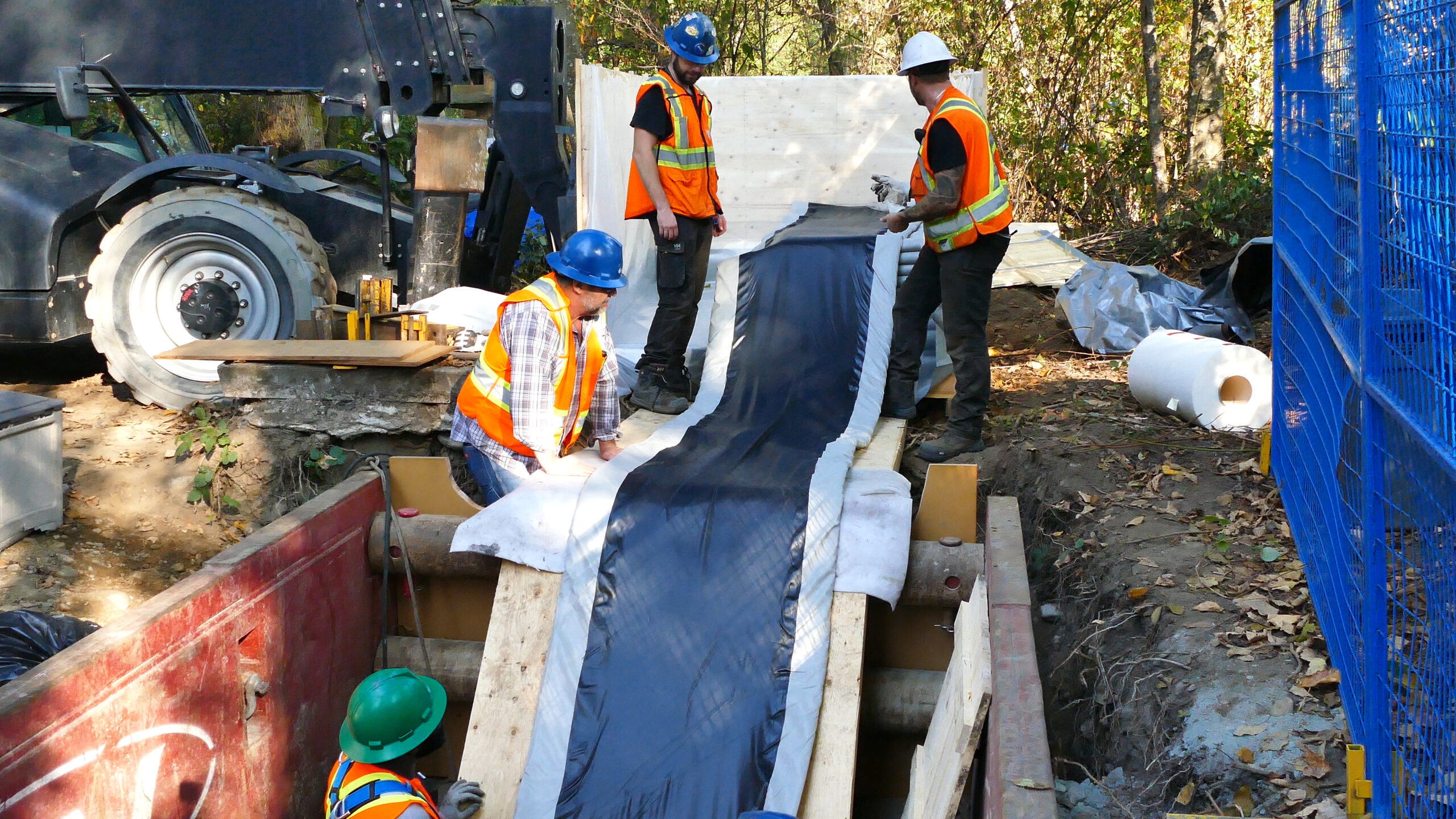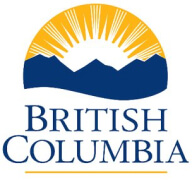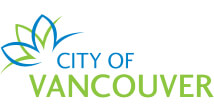
Cured in place piping is one of the most common forms of trenchless technology. First patented in the 1970s by an English inventor, CIPP is an effective repair method for all manner of underground pipes. In 2022, PW Trenchless completed a CIPP project for a local park. CIPP was an ideal solution for this project due to the sensitive ecosystem of the park, which serves as a breeding ground for herons and other threatened wildlife.
Underground pipes have a lifespan like everything else. Depending on the material and operating conditions, pipes may last anywhere from a decade to a century. As they reach the end of their operating life, pipes begin to leak and become prone to failure.
The CIPP process is used to repair worn out pipes “in place”. Rather than digging a trench and physically replacing the pipe, trenchless companies insert a sleeve or lining into the existing pipe. This lining is custom-sized to fit the length and diameter of pipe to be repaired. The lining is made from special cloth saturated with resin. Once it is in place, the resin is cured generally using heat or light. Once cured, the lining forms a durable barrier within the existing pipe—effectively creating a new pipe inside the existing trench.
The primary benefit of CIPP is that it typically requires little or no excavation. CIPP liners are usually inserted via existing access points like manholes.
By avoiding excavation, CIPP repairs may be completed without disrupting roads or landscaping. The process may be less carbon intensive than conventional replacement methods. As they require less excavation work, CIPP repairs tend to be less noisy and disruptive to neighbours.
CIPP repairs may become more complex for pipes with many bends, as ensuring the liner isn’t folded, wrinkled, or creased can be difficult. Once repaired, CIPP pipes cannot be mechanically cleaned using a snake or cable. They must be water blasted clean, assuming cleaning is necessary.
While CIPP repairs are safe and durable, it is important to take steps to minimize or eliminate chemical exposure during installation and curing. Some studies have identified incidents of chemical leeching into water because of CIPP repair. However, the risk of dangerous chemical exposure or long-lasting pollution can be mitigated through installation and management best practices.

In 2022, PW Trenchless worked in tandem with Insituform to rehabilitate a sanitary sewer line in Port Moody’s along the Shoreline Trail and Old Orchard Park. This was an environmentally sensitive project due to its proximity to the Moody Inlet and the sensitive ecology of the land surrounding the pipe. As a breeding ground for herons and other animals, completing the project without damaging the ecosystem was crucial.
PW Trenchless completed all civil works, including preparation and clearing for this project, installation and maintenance of a temporary bypass while CIPP installation was to be completed. Insituform handled the installation and curing of the CIPP liner.
The project began with a site study. The rehabilitation took place in an environmentally sensitive region adjacent to the Burrard Inlet. Ensuring the project could be done safely—for workers, park visitors, and the surrounding environment—was of paramount importance.
Two sections of pipe required rehabilitation. The first section was a storm sewer requiring conventional CIPP lining. The second phase targeted a sanitary sewer line with more complex access requirements and a different liner type required. The project required a temporary bypass to allow the work to be completed safely. PW Trenchless identified a bypass route and configured above-ground force mains to reroute sewage flows away from the affected section of pipe.
During site preparation, PW Trenchless identified and dug insertion pits at key input points to facilitate installation. The existing segment of pipe was prepared for cleaning and installation. PW Trenchless worked closely with Insituform to hand-off the project for installation.
Once site preparation was complete, Insituform proceeded with Liner works. They began by inspecting the section of pipe to be rehabilitated using remote cameras. The interior of the pipe was cleaned and prepared for CIPP installation.
Insituform installed fiberglass resin impregnated felt into the pipe before applying pressurized steam to cure the resin. This concluded the first phase of the CIPP installation.
The second phase involved an alternative UV-cured liner produced by iPlus®. Due to the absence of manhole access to this section of pipe, entrance and exit pits had to be excavated. A winch cable pulled the prepared lining through the pipe body. The Insituform team worked carefully to ensure the liner inflated properly before curing it with a remote lighting train.
Once the two remediated segments of pipe were cured, PW Trenchless proceeded with the reinstatement phase of rejoined the project. Their crew worked to connect the newly lined segments of pipe back to the grid, forming a continuous functional pipeline once more. Once all pipe was tested and functional, PW Trenchless removed the bypass systems put in place during site preparation. Each system was meticulously flushed and cleaned prior to disassembly to avoid contamination.
The project was a success, remediating both segments of pipe without significantly disrupting the park’s operations or the local ecosystem. Throughout the process, local herons continued to nest in the area, indicating little disruption to nature despite the extent of work completed.
An alternate tendering process where the contract is awarded to one entity which comprises both engineering and contracting.
Because PW Trenchless Construction offers such innovative solutions for underground utilities, it is often beneficial for the owner to request solutions based on a performance specification. This allows PW Trenchess to offer unique solutions while working with equally innovative engineering companies. Learn more about design - build here!
More InfoNew installation methodologies include HDD & traditional open cut Learn more about new installation here!
More InfoIn this day & age of pipe systems reaching the end of their projected lifespan, pipe replacement and pipe rehabilitation have become major fields of engineering.
PW Trenchless Construction provides viable options such as pipe bursting, loose fit lining and internal pipe re-construction whether partial & fully circumferential. Learn more about pipe replacement & rehabilitation here!
More InfoThe aging culverts under roads and highways in many case have reached the end of their engineered life-span. We consider the rehabilitation or replacement of these culverts to be vital to our built environment.
PW Trenchless has been a pioneer in working with MOTH, railway companies and municipalities in developing rehabilitation methodologies for the hundreds of thousands of culverts that currently exist in BC. We have offered solutions in both procurement and construction from design-build to sliplining, invert rehabilitation and full circumferential relining. Learn more about culvert rehabilitation here!
More InfoOften pipe failure can be concentrated to one section, for various reason, leaving the rest of the pipe in good condition. The repair of these localized failures are know as external point repairs (EPR's).
EPR's demonstrate PW's ability to work as both a trenchless and civil contractor, completing EPR contracts using our civil contracting skills and assisting other pure trenchless contractors who only have the capacity to work in an existing pipe. Learn more about point repairs here!
More InfoPipe upsizing is the fundamental concept of pipe bursting.
The vast majority of pipes are less than or equal to 200mm in diameter, but with today's densification practices of urban design, there is a major demand to increase current capacity to handle extra flow. Pipe bursting provides the ideal solution to this issue, particularly in an urban setting. Learn more about pipe upsizing here!
More InfoHorizontal Directional Drilling is a low impact Trenchless construction service where pipe is installed in a shallow arc along a bore path which has been created by a drilling rig. Often the terms Horizontal Directional Drilling (HDD) and Directional Boring are used interchangeably, but in our industry we use the word “boring” when we utilize smaller sized drilling rigs with small diameters for short crossings in the hundreds of feet, and we use the word “drilling” when we utilize larger rigs with large diameters for long crossings in the thousands of feet. Learn more about horizontal directional drilling here!
More InfoPrimus Line® is a flexible sliplining solution for the trenchless rehabilitation of pressure pipes. The system consists of a flexible Kevlar® reinforced liner and specially developed end fittings. Primus Line® is not bonded to the host pipe and is self-supporting. An annulus remains between Primus Line® and the host pipe.
Developed by experienced engineers, the system is suitable for different media as well as various application needs and has already proven itself in numerous projects.Learn more about primus lining here!
More Info
























When you join PWT, you become part of a community of people who are engaged in the most innovative practices in the Trenchless Industry. We have been instrumental in setting up a scientific method for cities to gain carbon offsets/credits from their use of trenchless construction. This system has been reviewed by the BC Government and has been approved as of December 2018. We expect to see it in common use shortly.
Subscribe to our newsletter for cutting-edge industry updates, expert knowledge, and exclusive content.